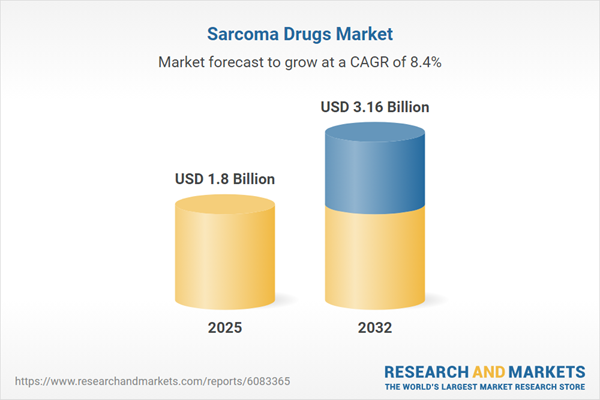Speak directly to the analyst to clarify any post sales queries you may have.
The sarcoma drugs market is evolving rapidly as new therapies, regulatory frameworks, and technology integration shape global treatment standards. Senior executives must monitor these shifts to support informed, forward-looking business strategies and maintain competitive advantage.
Market Snapshot: Sarcoma Drugs Market Forecast and Growth
The sarcoma drugs market is advancing on a steady upward path, with revenue forecast to grow from USD 1.66 billion in 2024 to USD 1.80 billion in 2025, reaching USD 3.16 billion by 2032 at a CAGR of 8.35%. Growth is fueled by increased adoption of precision medicine approaches, investment in emerging therapies for both common and rare sarcoma types, and digital health integration that optimizes care delivery. Regional market performance varies, influenced by healthcare infrastructure, regulatory landscapes, and payer policies. Each major geography—the Americas, EMEA, and Asia-Pacific—presents unique opportunities and distinct reimbursement challenges for stakeholders.
Scope & Segmentation of the Sarcoma Drugs Market
This report delivers comprehensive segmentation and actionable insights for senior decision-makers evaluating the global sarcoma drugs market. The analysis covers the following market segments, which reflect current innovations, clinical demand, and evolving healthcare requirements:
- Drug Classes: Insights into antiangiogenic agents, chemotherapy drugs including alkylating agents and anthracyclines, hormonal therapies, immunotherapies such as checkpoint inhibitors and adoptive cell therapies, and targeted agents like CDK4/6 inhibitors and tyrosine kinase inhibitors.
- Indications: Analysis extends across bone sarcomas like chondrosarcoma, Ewing sarcoma, osteosarcoma, gastrointestinal stromal tumors, Kaposi sarcoma, and major soft tissue sarcoma subtypes comprising leiomyosarcoma, liposarcoma, rhabdomyosarcoma, and synovial sarcoma.
- Routes of Administration: Coverage of oral, intravenous, intramuscular, and subcutaneous delivery informs evaluation of clinical workflow and patient preferences.
- End Users: Segmentation addresses ambulatory surgical centers, hospitals, specialty clinics, and home care providers—capturing every point of care and operational consideration.
- Treatment Modalities: Assessment includes combination therapies as well as single-agent regimens, highlighting evolving strategies in therapy design and the shift toward personalized medicine.
- Regions Covered: Americans (including United States, Canada, Mexico, Brazil, Argentina, Chile, Colombia, and Peru), Europe, Middle East and Africa (with focus countries such as UK, Germany, France, Russia, UAE, South Africa), and Asia-Pacific (notably China, India, Japan, and Australia).
- Key Companies: Profiles of leading industry participants, including Novartis AG, Bayer AG, Pfizer Inc., Ipsen S.A., Eisai Co., Ltd., Eli Lilly and Company, Deciphera Pharmaceuticals, Blueprint Medicines Corporation, Epizyme, Inc., and Merck & Co., Inc.
Key Takeaways for Industry Decision-Makers
- Precision medicine and advanced diagnostics are supporting the transition to more individualized sarcoma therapies across different patient populations and rare disease subtypes.
- Collaboration between research institutions and pharmaceutical companies is accelerating the progression from scientific discovery to clinical and commercial product launches.
- Integration of digital health tools, including real-time monitoring and next-generation sequencing, is improving treatment assessment and facilitating adaptive trial designs.
- Diversified administration options such as oral and subcutaneous therapeutics are expanding choices for clinicians and patients, improving convenience and adherence, especially in outpatient environments.
- Varying regional policy and payer requirements drive the need for agile commercialization models, with adaptive stakeholder engagement crucial for sustaining market access.
- Competitive pressure is especially strong in Asia-Pacific, where the uptake of biosimilars and generics is accelerating, while established markets are emphasizing value-based healthcare delivery models.
Tariff Impact and Operational Strategies
Recent United States tariffs on active pharmaceutical ingredients and finished products have increased manufacturing costs throughout the supply chain. To address these pressures, pharmaceutical companies are optimizing supply networks—moving production closer to key markets, building regional partnerships, and utilizing digital supply chain management systems to assure continuity and manage pricing risks. Advocacy by trade organizations remains an important tool for achieving relief on critical oncology components and maintaining stable operations.
Methodology & Data Sources
This report synthesizes robust secondary research, including regulatory publications and industry databases, with primary interviews from sector experts and commercial leaders. Findings are validated through data triangulation and peer review to ensure credibility for executive decision-making.
Why This Report Matters to Senior Decision-Makers
- Enables confident prioritization of investment initiatives aligned with global and region-specific market opportunities in sarcoma drug development.
- Shares actionable guidance for strengthening innovation, improving patient reach, and proactively managing operational and regulatory risks across geographies.
- Supplies reliable intelligence to support R&D, commercialization strategy, and cross-border expansion initiatives.
Conclusion
This analysis gives senior leaders the strategic perspective and practical knowledge needed to drive effective sarcoma drug commercialization and development, supporting clinical advancement and operational resilience in a changing global context.
Table of Contents
3. Executive Summary
4. Market Overview
7. Cumulative Impact of Artificial Intelligence 2025
Companies Mentioned
The companies profiled in this Sarcoma Drugs market report include:- Novartis AG
- Bayer AG
- Pfizer Inc.
- Ipsen S.A.
- Eisai Co., Ltd.
- Eli Lilly and Company
- Deciphera Pharmaceuticals, LLC
- Blueprint Medicines Corporation
- Epizyme, Inc.
- Merck & Co., Inc.
Table Information
| Report Attribute | Details |
|---|---|
| No. of Pages | 180 |
| Published | October 2025 |
| Forecast Period | 2025 - 2032 |
| Estimated Market Value ( USD | $ 1.8 Billion |
| Forecasted Market Value ( USD | $ 3.16 Billion |
| Compound Annual Growth Rate | 8.3% |
| Regions Covered | Global |
| No. of Companies Mentioned | 11 |









